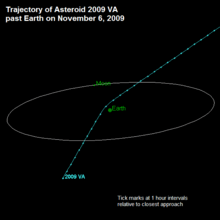2009 VA
| Discovery | |
|---|---|
| Discovered by | Catalina Sky Survey |
| Discovery date | November 6, 2009 |
| Designations | |
| none | |
| Apollo (NEO) | |
| Orbital characteristics[1] | |
| Epoch 6 November 2009 (JD 2455141.5) | |
| Uncertainty parameter 8 | |
| Aphelion | 1.9382 AU (289.95 Gm) |
| Perihelion | 0.91768 AU (137.283 Gm) |
| 1.4280 AU (213.63 Gm) | |
| Eccentricity | 0.35735 |
| 1.71 yr (623.26 d) | |
| 338.95° | |
| 0° 34m 39.396s /day | |
| Inclination | 7.5411° |
| 224.54° | |
| 223.99° | |
| Earth MOID | 0.000130811 AU (19,569.0 km) |
| Jupiter MOID | 3.30322 AU (494.155 Gm) |
| Physical characteristics | |
| Dimensions | 7 m |
| 28.6 | |
|
| |
2009 VA is an asteroid that came within 14,000 kilometres (8,700 mi) of Earth on November 6, 2009 making it the 3rd closest non-impacting approach of a cataloged asteroid.[2]

The trajectory of the object as it passed Earth
With a diameter of only 7 metres (23 ft), scientists think that even if it had been on a direct collision course with Earth, it would have likely burned up in the atmosphere.[3] The space rock made its pass by Earth just fifteen hours after its discovery.[4]
The asteroid was first discovered by the Catalina Sky Survey at the University of Arizona. It was determined that the object would make a pass well within the orbit of the Moon, but would not strike Earth. The object passed so close to Earth that its orbit was modified by Earth's gravity.[4]
See also
- 2008 TC3
- 2010 RF12, 2010 RX30, 2010 TD54 - a similar-sized asteroids that passed Earth in 2010
- List of notable asteroids#Record-setting close approaches to Earth for other, closer approaches
References
- ↑ "JPL Small-Body Database Browser: (2009 VA)". Jet Propulsion Laboratory. Retrieved 31 March 2016.
- ↑ "Small Asteroid 2009 VA Whizzes By Earth". Science Daily. Archived from the original on 15 November 2009. Retrieved 2009-11-11.
- ↑ Small Asteroid Spotted Flying Close To Earth, redorbit.com, November 11, 2009
- 1 2 Alan Boyle. "Space rock buzzes past Earth". MSNBC. Archived from the original on 14 November 2009. Retrieved 2009-11-11.
External links
- Small Asteroid 2009 VA Whizzes By The Earth
- JPL Small-Body Database Browser: (2009 VA)
- 2009 VA at the JPL Small-Body Database

This article is issued from
Wikipedia.
The text is licensed under Creative Commons - Attribution - Sharealike.
Additional terms may apply for the media files.